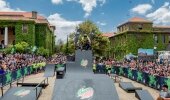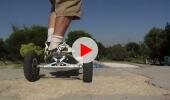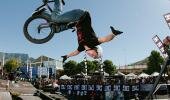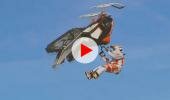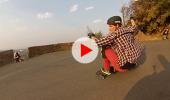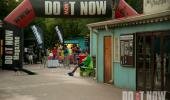Words: Damien Laird | Photos: Lerissa Kemp
Do you want to start skateboarding and FInd out more about this ever-growing sport? This is a story about my introduction to the skateboarding scene and how I came to meet other skaters, who have positively inFluenced my days.
Photo credit: Lerissa Kemp
When I was 14 my uncle bought me a new PlayStation game. It was the latest Tony Hawk’s Pro Skater and together we completed each goal in the game. For those of you who may have not heard of Tony Hawk, he is one of the pioneers who revolutionised the approach to skateboarding tricks and as a result the sport has become very popular worldwide. It was not long after when I watched my first professional skate competition on TV; I was totally enthralled. I’m so happy that I taped the action, as I was able to study the numerous tricks performed and it helped me to recognise many of the different types of tricks that make up a good competition run. A trip to the Gateway Skatepark in Durban and seeing how much fun the skaters were having was all it took for me to realise that I too wanted to skateboard.
On choosing my first skateboard at Sidewalk Surfer in Fourways Mall, my lesson on the ins and outs of the sport began. For example, you can buy a complete set-up, meaning a fully equipped, good to go skateboard, or you can customise your own set-up by purchasing the parts separately and assembling everything in the shop or at home later. I went for the customised version and enthusiastically chose each and every part, and then watched in awe as the shop assistant expertly put it all together.
A standard skateboard consists of a deck, which is a wooden board made of typically seven or nine plies of wood. A sticky sheet of sand paper, known as grip tape, is applied to the deck’s surface. It is this grip tape that enables you to manoeuvre the board, as it ‘grips’ your shoes when moving your feet in specific ways, to perform each trick. A set of trucks are then bolted onto the deck and these are essentially the axles of the skateboard. Trucks provide the suspension needed to turn whilst riding and absorb the pressure of your body weight as you land on the board. Wheels and bearings are then combined and slotted onto the trucks to complete the set-up. You can choose from different types of ABEC bearings, which are used to vary the speed of your skateboard. It is also advisable to buy riser pads, thin rubber sheets that fit between the trucks and deck. The pads act as shock absorbers, thus prolonging the life of the wooden deck. A useful tip is to look for a skate tool, as it is the only apparatus necessary in taking a skateboard apart and putting it back together.
Once everything was assembled, I then learnt about safety gear and the protection offered in the event of a fall. I would seriously recommend that every skater uses a helmet, knee pads, elbow pads and wrist guards when attempting to progress their skills. If you are worried about wearing a helmet and not looking cool, don’t! Most skateparks insist on skaters wearing helmets, and even if they do not, it’s just plain smart, especially when you first start out. Honestly, when riding big ramps, I am thankful to say that my helmet has protected me from potential head trauma. It is much better to be safe than sorry.
If you are looking for the best products, there are loads of skate shops that can help you to get kitted out with the essentials. To name a few of these places, look out for a Boogaloos, Sidewalk Surfer or Revolution skate shop near you. You will find skateboards, shoes, clothes and so much more in these stores.
Riding in parks is where I officially fell in love with skateboarding; it’s fun, social and you get to see what the other skaters are doing. So when looking for a skatepark to session, you will find a range of Boogaloos parks around the country on the internet. In Gauteng, there’s a concrete park at Stoneridge in Edenvale, another at Brightwater Commons and some concrete ramps in Fourways. You should also check out the ramp parks in Menlyn and at the Festival Mall in Kempton Park. For anyone looking to ride a big ramp, there is a halfpipe established at Base 3 Cableski in Midrand. The beauty about skating is that you can ride your board almost anywhere. However, there are parks in all the major cities and other skaters are always willing to share the areas they know of with you. So it doesn’t matter where you are from, as there’s sure to be a spot near you.
There are three main
types of skateboarding
• Park skating refers to being in a skatepark and developing your style over ramps of various shapes and sizes that you will encounter.
• Vert skating is for anybody who wants to learn how to ride a halfpipe. This is one massive ramp that curves up on opposite sides until each side is vertical, which allows people to air right out the top of the ramp and then land back in the ramp on their way down.
›› Street skating is an option if you are unable to access these places. Skaters achieve this by practising their technical skating skills and moves anywhere and on any obstacle. For instance: stairs, rails and walls. Just remember to only ride in safe and secure areas.
When it comes to the types of tricks that are possible, you need to be aware of:
• Flips are done by kicking the board around as you jump, so that it flips over or spins around, or both, and then lands back in place under you so that you can continue to ride away without touching the floor with your feet.
• Grab tricks are when a skater is airborne and then grabs hold of their board with either hand, on any side of the board, whilst stylishly floating above the ground.
• Rail tricks are variations of how a skater slides across a rail or ledge on the board or trucks, and each trick is a specific grind.
• Spins are when a skater turns their entire body with the board. Spins are named according to the direction of the turn and are measured by the amount of degrees rotated, such as a backside 180 or frontside 360.
These days the level of skating is really high, as different types of tricks are combined to create even harder tricks. An example of this is a kickflip to melon grab with a frontside 180.
Every skateboarder will have a natural tendency to move forward with either a left or a right body positioning. All tricks are done in whichever direction. The different ways of placing yourself on the board are known as respective stances. If you find it better to have your right foot in the front, then you are a goofy stance rider. Regular footed riders lead with their left foot. This is like being left or right handed and good skateboarders can do tricks in both directions. When showcasing a trick in the opposite direction to which you usually ride, this is known as riding in switch stance and performing each skateboarding act switch. An example of this is a switch heelflip.
Over the years I have met some amazing, friendly and down to earth people that I enjoy skating with regularly. My friends have helped me to increase and improve my skills, and we have the best times socially, sharing a laugh and going wherever our boards decide to take us on the day.
Photo credit: Lerissa Kemp
One such friend is Craig Hebrard and this is his take on skateboarding.
Q: How did you get into skateboarding?
A: In the beginning it was always a social thing, chilling with friends and competing with each other. Now the only reason is to get better.
Q: Are you a goofy (skating with your right foot forward) or a regular footed rider (skating with your left foot forward)?
A: I’m regular.
Q: What do you love about being on your board?
A: The clarity I get from concentrating on the trick I’m doing.
Q: Where is your favourite spot to skate?
A: The road outside my house.
Q: What are your two most enjoyable tricks?
A: Fakie backside flip and fakie pressure hardflip.
Q: Which professional skater gives you the most inspiration and why?
A: Rodney Mullen. He is THE best flatland skater that has ever lived, rivalled by few. He has been able to do stuff on a board that boggles even the best of skaters’ minds.
Q: What advice do you have for new riders wanting to improve?
A: Skate hard, as often as you can, and never forget that all wounds will heal.
Q: Say something cool.
A: Stick a trick big or don’t stick it at all. Have fun and never let life get the better of you.
So there you have it, straight from the mouth of a skateboarder.
If you are just starting out or already an accomplished skater, remember not to put pressure on yourself to be better than others. There is no real competition when we do this for the love of the sport. The way to do well is to focus on your own riding and as long you can progress personally from day to day, that is the ultimate. Be happy for your friends if they learn something new and don’t take any trick for granted. I am always ready to help my fellow athletes to grow because in skateboarding we all learn from each other, and I want everybody to do well. Some tricks do take a while to land consistently, so work hard and know that even the professionals started with the basics. The only thing left to say is, “Go skate with your heart and you will FInd that love in any experience.”

